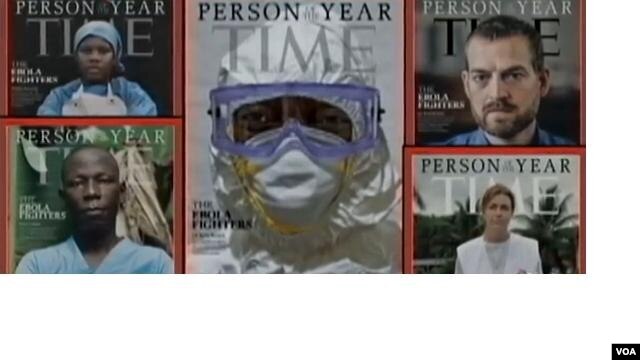
If asked, “What was the most important health story of 2014?” there would be little debate.
Ebola has killed more than 6,800 people and infected more than three times that number.
But this is not the first time the world has heard of Ebola. The virus spent many years in African forests far from human populations. Every ten years, or so, it would appear in small villages and kill a few hundred people.
But the Ebola outbreak that began in 2014 is very different than all that came before.
This time, Ebola is sickening thousands of people in West Africa. It crossed into cities and over national borders. The world reacted with shock and fear.
And Ebola continues to kill.

Tracking the steps of a killer
The Ebola outbreak began in rural Guinea a year ago. Months passed before health officials identified the virus. The disease spread to the capital and crossed into Sierra Leone and Liberia. By June, cases began to rise quickly in those two countries.
Misunderstanding, miscommunication and fear also grew.
Some people resisted treatment and safe burials of their loved ones. People near the Liberian capital, Monrovia, rioted. Frightened people sometimes killed aid workers who had travelled to affected villages to help.
Governments answered the panic with lockdowns and quarantines. They put infected people in restricted communities.
But governments also increased education efforts. Health officials warned people to take safety guidelines seriously. Health workers walked the streets teaching people about the signs of Ebola. Today health workers continue to go door-to-door looking for possible cases.
How to fight a killer virus
To stop Ebola doctors must separate infected people from non-infected people. Health care workers must have special training to treat the sick. They must wear head-to-toe protective clothing. Sometimes, even those that follow these steps still get sick.

Doctor Kevin Brantly and aid worker Nancy Writebol are examples. They understood the risks and followed the safety measures. Yet, they became infected with the virus while working with Ebola patients in Liberia. The two health care professionals were taken to the U.S. for treatment. Each took the experimental drug called zMapp and recovered. ZMapp is made from tobacco plants.
Health care workers like Dr. Brantley and Ms. Writebol are most at risk. It is estimated that 350 such workers in West Africa have died from Ebola. Sierra Leone lost three doctors in the first half of December alone.

Ebola exposes broken health care systems
Ebola has shown the weaknesses in health care systems in the most affected countries. By September, hospitals had closed in Monrovia. There were not enough beds or workers at Ebola treatment centers.
People with other sicknesses who look for treatment are often exposedto Ebola patients.

VOA Learning English spoke to a doctor who got Ebola while working with HIV-AIDS patients in Liberia. Dr. Rick Sacra says a broken health care system is the biggest issue in Ebola-affected areas.
“So, we have a terrible situation right now in both Liberia and Sierra Leone where pregnant women who can’t deliver and need a C-section many of them have nowhere to go because the health facilities around them are closed. So, we need to remember this is not just about Ebola. There is a ripple effect into the health system as a whole.”
Ebola is a life-changer
In Guinea, Sierra Leone and Liberia, people no longer shake hands or hug. Physical contact has become too risky.
People can no longer care for their sick or bury their dead in traditional ways. The bodily fluids of Ebola patients, as well as the Ebola dead, carry the virus.
Border health officials stop and check people traveling out of West Africa for signs of infection. Measuring body temperature has become common at airports and border crossings. Fever is one of the first signs of Ebola.

When will there be a cure or vaccine?
French researchers are developing an Ebola test to provide results in 15 minutes. The current Ebola test takes 24 hours. Japan and the United States are also working on developing faster tests.
Lausanne's University Hospital in Switzerland began testing a possible Ebola vaccine in November in healthy volunteers. Experts say there is no danger of getting Ebola from the vaccine. If the vaccine proves effective, researchers will organize tests with larger groups.
Dr. Sacra adds that some treatments for Ebola are showing promise. He talks about “convalescent plasma,” using the blood of Ebola survivors to save those sick with the disease.
“It is exciting. They are now beginning clinical trials on a larger scale of both medications and this “convalescent plasma” to really prove whether they work or not.”
Since recovering from Ebola Dr. Sacra says he is now immune to the virus.
I’m Anna Matteo.
Words in this Story
expose – v. to not be shielded or protected from
panic – n. a state or feeling of extreme fear that makes someone unable to act or think normally; a situation that causes many people to become afraid and to rush to do something
quarantine – n. the situation of being kept away from others to prevent a disease from spreading
immune – adj. not capable of being affected by a disease
“My first three days that I was sick all I had was a fever. Chills and fever. And that was really it … maybe a little headache. Then by the third and fourth day I started having stomach problems … vomiting … diarrhea. After that you start doing that for awhile you start to get weak because you start to get dehydrated.”
“This is why it is so important to get treatment early because if you wait, if people wait while they’re having those symptoms of vomiting and diarrhea they end up getting dehydrated and don’t even have a chance to live through it (Ebola) they just lose all their fluids.”
“I think anyone doing direct patient care in West Africa, whether it’s in an Ebola treatment center or just in a general health facility .. because I was not treating Ebola patients I was in a general health facility … everyone is at risk. And people need to know that there is a risk when they’re working.”
“We have a terrible situation now in both Liberia and Sierra Leone where pregnant women who can’t deliver and need a C-section many of them have nowhere to go because the health care facilities around them are closed. Remember this is not just about Ebola. There is a ripple effect into the health system as a whole.”
"I know some of the groups that are going in like the University of Massachusetts is sending a team now with some grant funding behind them -- that will really be focused on reopening general health facitlities because of this problem."
“I do hope to go back. I don’t have my tickets yet. But I do hope to be back early next year … for another month and continue to work there.”
“They tell me I’m immune now which is good. If I’m able to donate to help others I’d be happy to do that. It is exciting. They are now beginning clinical trials more serious, scientific trials on a larger scale of both medications and this “convalescence plasma” to really prove whether they work or not. And that’s going to be very helpful. Because once we have the proof, the scientific proof, we can move forward with more confidence.”

